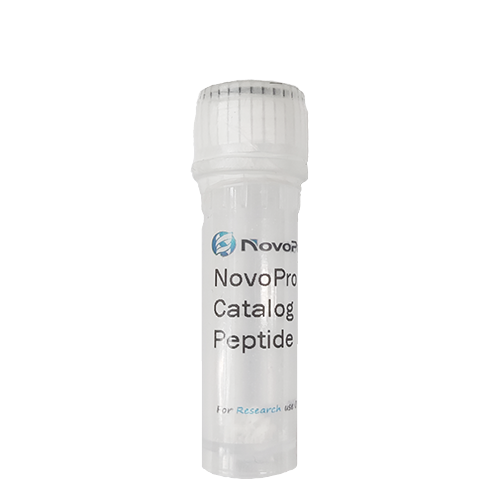Rusfertide peptide
Not For Human Use, Lab Use Only.
Cat.#: 319741
Special Price 629.00 USD
-
Product Name
Rusfertide peptide
-
Documents
Batch to batch variation of the purity
-
Sequence Shortening
{Asp(N-(3-methyl-1-oxobutyl))}-THFPCI-{Lys(γGlu-C16 acid)}-FEPRSKGCK-NH2 (disulfide bridge: Cys6-Cys16)
-
Sequence
{Asp(N-(3-methyl-1-oxobutyl))}-Thr-His-Phe-Pro-Cys-Ile-{Lys(γGlu-C16 acid)}-Phe-Glu-Pro-Arg-Ser-Lys-Gly-Cys-Lys-NH2 (disulfide bridge: Cys6-Cys16)
-
Length (aa)
17
-
Peptide Purity (HPLC)
95.46%
-
Molecular Formula
C114H181N27O28S2
-
Molecular Weight
2442
-
CAS No.
1628323-80-7
-
PubChem CID
155884410
-
Source
Synthetic
-
Form
Powder
-
Description
Rusfertide(PTG-300) is a peptide mimetic of natural hepcidin, which targets the major iron transporter, ferroportin, and causes its internalization and subsequent degradation. This leads to reductions in serum iron and transferrin saturation (TSAT) due to reduced ferroportin expression on cells that store or recycle iron. Rusfertide ameliorates the polycythemia vera, β-thalassemia and hereditary hemochromatosis.
-
Storage Guidelines
Normally, this peptide will be delivered in lyophilized form and should be stored in a freezer at or below -20 °C. For more details, please refer to the manual: Handling and Storage of Synthetic Peptides
-
References
- Roopa Taranath, Gregory Bourne, Li Zhao, Brian Frederick, Chelsea King, David Liu, Regulation of Iron Homeostasis By PTG-300 Improves Disease Parameters in Mouse Models for Beta-Thalassemia and Hereditary Hemochromatosis, Blood, Volume 134, Supplement 1, 2019, Page 3540, ISSN 0006-4971, https://doi.org/10.1182/blood-2019-129309.
-
About TFA salt
Trifluoroacetic acid (TFA) is a common counterion from the purification process using High-Performance Liquid Chromatography (HPLC). The presence of TFA can affect the peptide's net weight, appearance, and solubility.
Impact on Net Weight: The TFA salt contributes to the total mass of the product. In most cases, the peptide content constitutes >80% of the total weight, with TFA accounting for the remainder.
Solubility: TFA salts generally enhance the solubility of peptides in aqueous solutions.
In Biological Assays: For most standard in vitro assays, the residual TFA levels do not cause interference. However, for highly sensitive cellular or biochemical studies, please be aware of its presence.
-
Molar Concentration Calculator
-
Dilution Calculator
-
Percent Concentration Calculator
Mass (g) = Concentration (mol/L) × Volume (L) × Molecular Weight (g/mol)
Related Products / Services
• Peptide Services: NovoPro's peptide synthesis services include standard chemical peptide synthesis, peptide modification, peptide libraries, and recombinant peptide expression.
• Standard Peptide Synthesis: NovoPro offers quality peptides at the most competitive prices in the industry, starting at $3.20 per amino acid. NovoPro provides PepBox – Automatic Quote Tool for online price calculation.
• Peptide Modifications: NovoPro offers a wide range of peptide modification services including isotope labeling (2H, 15N, and 13C), multiple disulfide bonds, multiple phosphorylations, KLH, BSA, ovalbumin, amidation, acetylation, biotin, FITC, etc.
Please note: All products are "FOR RESEARCH USE ONLY AND ARE NOT INTENDED FOR DIAGNOSTIC OR THERAPEUTIC USE"

